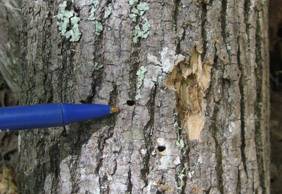
Populations of EAB can take years to build up, but once population levels are high, ash trees die in one to two years. The sooner you act, the more management options are available. Knowing where the ash trees are on your property is crucial to making management decisions.
Yard, Park and Street Tree Management
There are basically three options for urban ash tree management:
- Ash trees can be removed and replaced
- Treated with systemic insecticides until they can be removed
- Treated with systemic insecticides for the duration of the infestation
EAB Cost Calculator
The EAB Cost Calculator 3.0 helps you compare costs of replacing trees as they die to preemptive replacement and an experimental approach to management called URBAN SLAM.
Woodlot Management
It is not necessary to remove every single ash tree on your property if they pose no threat to your use of the land. Standing dead trees can be good wildlife habitat and rotting logs will decay and return nutrients to the soil. Also, as more research is conducted, any remaining ash trees may be saved through future control options and, there is still hope that an EAB resistant ash tree will be found; maybe it will be yours.
Yard Tree Management
Know where the EAB infestation is, and wait until the Emerald Ash Borer is less than 10 miles away. Depending on the product used you will need to treat your trees every one to three years. You will be wasting your money if Emerald Ash Borer is not a threat in your area. Young, vigorously growing trees are going to respond best to application of systemic insecticides. It’s easy to save a tree if there are no infestations in your vicinity. Even with an infestation, it will often take more than three years for a tree to die. So beware of short term guarantees to save your tree. Oftentimes, it is best to remove large or damaged trees.
Municipal Tree Management
Communities and governments should have a plan in place for managing ash trees before, during, and after EAB infestation in order to minimize economic impacts. Dead ash trees pose a tremendous public safety threat as dead ash trees shed limbs. Their management can be a substantial financial burden for municipalities but planning ahead can reduce costs and management problems.
Completion of a tree inventory, either a complete inventory or an ash only inventory, will define the scope of the situation and allow you to explore different management options given various budgetary constraints. To decide which actions to take, you need to consider many variables: Is the tree in a high use area, or at the back of an unused field? Is the tree in wires, over a building, or on the street? Consider the size of the tree. Removal and treatment costs change as the size of the tree increases. Poor condition trees are not good candidates for insecticide treatments. Is the ash tree in a very prominent location in your community? How will the community react to the removal of that tree or group of trees?
The Coalition for Urban Ash Tree Conservation supports the conservation of ash tress through treatment and argues that it can be less expensive than removing and replacing trees when the value of established trees and the risks and removal costs of standing dead trees are considered.
Municipal Plan
Cornell Cooperative Extension has developed a workbook for communities to use in developing their own management plan for the Emerald Ash Borer.
New York Emerald Ash Borer Management Plan Development Workbook
Community Task Force
An EAB Community Task Force is a group of people in key positions and with specific skills that can help their greater community plan and prepare for this invader. EAB Task Forces should encompass more than one municipality. They could be multiple towns, county-wide, multiple counties, or even regional. The scale of the projects, the level of communication, and the individuals involved will all change with the scale. An EAB Task Force can be used for several jobs, such as conducting ash tree inventory, communicating between municipalities, sharing resources, and minimizing economic impact. Get in touch to learn more about community task force projects.



